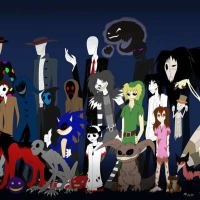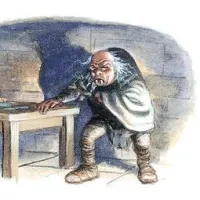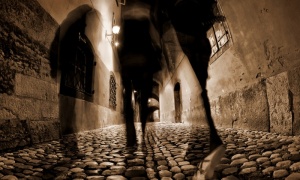Locke & Key is an American comic book series written by Joe Hill, son of Stephen King and a noted horror author in his own right, and illustrated by Gabriel Rodríguez. Quite simply, the series stands as one of the greatest works of modern horror in any medium. It begins with the brutal murder of the Locke family’s father and then moves the survivors of the attack back to their ancestral home, Keyhouse, in Lovecraft, Massachusetts. It may sound a bit hokey and contrived, but the reality is far different. After that shaky little pitch, the comic book series becomes a spellbinding reading experience, demanding page turns as the family comes to terms with its haunted past. The Keyhouse has magical keys that allow their users powers. These keys start revealing themselves to the Locke kids, who use the keys not only for their special powers, but in various attempts to deal with their trauma and to aid them in the struggles of adolescence and fitting in, as a malevolent force bent on unleashing demons long buried hounds them. That concept allows for some incredibly gripping moments throughout the series, which make reading the series’ finale a bittersweet experience.
Hill crafts a gripping account of the shattered Locke family’s attempt to rebuild after the father/husband is murdered by a deranged high school student and the family subsequently moving in with the deceased father’s brother at the family homestead in Maine. But as anyone who has read horror fiction in the past 70-odd years will tell you, it’s a bad idea to try to leave behind the gruesome goings-on in your life by moving to an island named “Lovecraft.” What begins as a study in coping with grief soon veers into creepy territory as the youngest Locke discovers a doorway with decidedly spectral qualities, along with a well that houses someone or something that desperately wants out and will use any means available to gain freedom, including summoning the teenage murderer who set events in motion in the first place. To say more would give away many of the surprises the creative team provides, but suffice to say that the solid story is bolstered by exceptional work from Chilean artist Rodriguez (Clive Barker’s The Great and Secret Show ) that resembles a fusion of Rick Geary and Cully Hamner with just a dash of Frank Quitely.
There are many reasons to read Locke & Key. Though this series is about a demon trying to take over our world, a house filled with magical locks and keys, and the struggle between good and evil, it is also an incredibly heartfelt family drama and coming of age story. At the emotional and narrative fulcrum of it all are the Locke kids: Tyler, Kinsey, and Bode. Each character reveals a unique aspect of adolescence and childhood. Through them we are provided entry points to this weird world because even though we will never experience either the magic of the trauma of this family, we understand the basic human and adolescent things that each kid goes through. The youngest, Bode, gets to go on adventures and find the keys. He’s whimsical with wild imagination, and we’ve all known fun kids who were like that. Kinsey, the middle child, is a young teen. She’s struggling with fitting in, finding out who she is, understanding how to deal with the world. Tyler, the eldest, has to step up and become the family patriarch, taking care of not only his siblings, but his mother who can’t seem to recover from their father’s death. He has to keep it together, all while trying to be one of the cool kids is school and trying to get a girl to like him. Basically, we get all the travails of youth, but amplified because of the trauma and then the supernatural goings on. With these characters we are grounded in real emotional struggle, which makes the series feel realistic and meaningful.
One of the tricky things about using magic in a story is trying to set limits or rules to the magic. If you don’t set up the rules, then almost anything can happen through the wave of a wand or an incantation. This can really lower the stakes in the story, and it’s one of the frustrating things about reading stories that rely on magic. Sometimes someone just shows up, casts a spell, and everybody’s happy. Locke & Key works around this by limiting the magic that can be wielded to the person holding the specific key and what that key does. The keys do some pretty amazing things. The Head Key lets you look into people’s heads, putting things in there or taking things out as you wish. The Shadow Key lets you control shadows. The Giant Key turns you into something that can fight a Kaiju! The keys do all kinds of cool things, but they don’t let the characters do anything and everything they want. There’s no magical reset button, no easy escape. And because of the limiting of the magical power that can be wielded, you get a sense that there is so much at stake. This comes to the fore as the keys change hands and we see what can happen when an evil character uses the keys. Though the world is built around magic, the consequences of the use of magic can feel almost too real.
The world of Locke & Key is enormous and lived in. One of the teases at the end of the first book is that you think it’s only the beginning of the story, but in truth it is actually very close to the end of things. We begin with the propulsive first collection, Welcome to Lovecraft, which introduces us to the Locke family in the present as they move back to Keyhouse and begin to discover the magical forces at work in our world. The keys begin to manifest and the house itself becomes a place of wonder, discovery, and sometimes horror. After this first collection which sets the stage, we start seeing how expansive Lovecraft really is. In the later books, we see how Hill and Rodriguez have created this world. The story spans generations, and the generation of the Locke kids’ father, Rendell, is only the most recent tragedy in their family history. This history, revealed through the use of new keys being found, of course reaches back to the American Revolution. And with other books in the series we are given little vignettes of the events that happened in Keyhouse before these most recent Lockes moved in. There’s so much in play. The keys, demons, a haunted past, and even a group of teens going into a cave two decades ago are merely parts of this rich mythology formed around the place and these characters.
The series’ Big Bad will come in many forms and go by many names, but each and every iteration is frightening. And just when you think you’ve caught a break, the Big Bad will find a way to come back even scarier and more powerful. Think something akin to Loki, in that the villain is manipulative and conniving. But this one is so much worse in what it is capable of doing and its single-minded drive to acquire the keys and bring its demonic plans to fruition. A brilliant stroke employed by the creators is keeping this villain in frighteningly close proximity to the Locke kids. Yup, this villain takes the form of one of their friends, and we’re stuck in that state where we want them to discover how evil this person they trust is, and we can do nothing but watch and hope. It’s chilling to watch how easily the Big Bad changes forms, inserts into groups,friendships, and relationships. And there’s a cold-bloodedness to the actions that is sometimes difficult to look at. The heights of evil which we are forced to watch, whether it’s in the overt grisly actions, or the scheming, coercing, and manipulating, is sometimes almost unbearable. And also part of what makes this such amazing reading.
Finally, I think one of the things that we’ve been burned by a lot in pop culture is the thing that falls apart in the third act, the last season, or just the plain ending. Well, no fears of that with Locke & Key. With the final issues, Locke & Key gives us first an action-filled crescendo to rival any blockbuster ending sequence. When I was reading the first issue I was left breathless and gasping with each page turn. With the second issue, which serves as denouement or epilogue, I was on the verge of tears. It’s hard to stick the ending, especially with such a massive work as this. Here the creators deliver, and it is a rewarding reading from start to finish. All loose ends are tied up, characters are given satisfying resolutions, and we are given a sense that while this world and these characters go on, the specific story that we needed to hear has been told. Most importantly, it works on the level of coming of age story. It’s a story about dealing with not just your own teen stuff, but also your family history. We are, inevitably, our parents’ children. We have to face their dreams, their limitations, where they were from, and how those things shaped how they raised us. It’s a coming to terms with the world we know as youths, the frightening world of being an adult and losing the magic of youth, and all the dark spaces between.

















Reblogged this on Hugh Paxton's Blog and commented:
Hugh Paxton’s Blog had no idea Stephen King had a son or that the son was an author of horror comics. Perhaps that’s not surprising if he calls himself Joe Hill. Anilbalan, author of the Ghost Cities blog, clearly rates him highly. The premise behind Locke and Key strikes me as a bit peculiar (going on far-fetched) but if it gets an Anilbalan thumbs up it is definitely worth a look. Ghost Cities is an excellent blog and Anilbalan is rarely wrong!